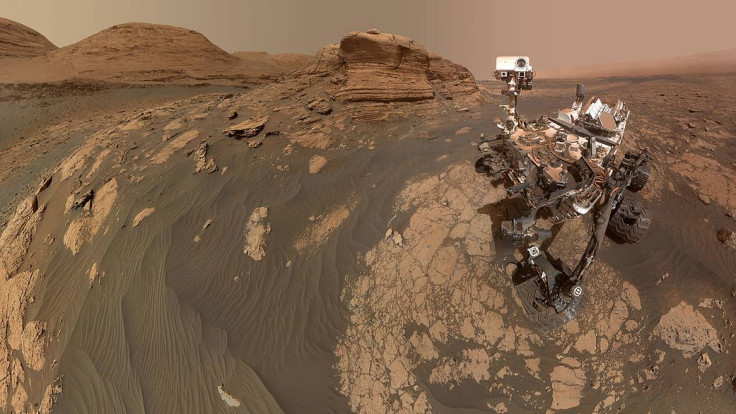NASA Mars Rover Takes Hi-Res Selfie With 20-Foot 'Mont Mercou'
KEY POINTS
- NASA's Curiosity Mars rover snapped a selfie with a rock outcrop on the red planet called "Mont Mercou"
- The selfie comprised more than 60 images taken by the rover's Mars Hand Lens Imager and Mastcam
- Nontronite, a type of clay mineral found close to Nontron, France, was detected in the area
As the NASA Perseverance rover begins its journey on Mars, Curiosity is already well into making itself comfortable. The rover, which landed on the red planet in 2012, recently shared photos of Mont Mercou, a 20-foot (6 meters) rock formation on Mars.
Using its Mars Hand Lens Imager (MAHLI), Curiosity was able to snap 60 images of itself in front of Mars' Mont Mercou on Friday. These images were then combined with 11 images taken by the rover's Mastcam on March 16 in order to create one breathtaking selfie, which can be viewed below.
The hole visible to the left of the rover in the image is where its robotic drill sampled a rock nicknamed “Nontron,” NASA said in a statement. Curiosity's drill did this by powderizing the sample first before it was fed into the rover's instruments. This was the mission’s 30th sample to date.
The sample will be analyzed by scientists to learn more about the composition of rocks around the area where Mont Mercou is located as well as to gain more insight into the red planet's past.
This outcrop is located between the “clay-bearing unit” Curiosity is departing and the “sulfate-bearing unit” it is heading to on Mount Sharp. Researchers are hoping that this area “might reveal what happened to Mars as it became the desert planet we see today,” according to NASA.
A selfie was not the only thing Curiosity was able to take. The clever robot also managed to provide a pair of panoramas using its Mastcam on March 4. It did so by taking a panorama shot about 130 feet (40 meters) away from the rock formation, then rolling to the side and taking another shot from the same distance.
The result showed a stereoscopic effect that is similar to those seen in 3D viewfinders and would allow scientists to get a better idea of the geometry of Mont Mercou's sedimentary layers, NASA stated.
The outcrop was named after France's own Mont Mecrou, located near the village of Nontron in the southeast of the country. This is because scientists were able to detect nontronite in this Mars region. This type of clay mineral can be found on Earth, near Nontron.
Curiosity and Perseverance, although on the same planet, are still miles apart -- about 2,300 miles, to be exact. The Perseverance rover has been busy searching for signs of ancient microbial life in the Jezero Crater, while Curiosity has been steadily climbing the 3-mile-high Mount Sharp since 2014.

© Copyright IBTimes 2025. All rights reserved.





















